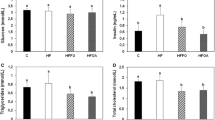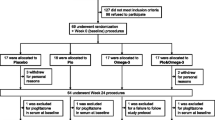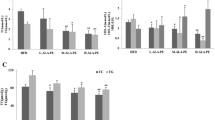Abstract
Preclinical and clinical studies demonstrate that the omega-3 fatty acids docosahexaenoic acid (DHA) and eicosapentaenoic acid (EPA) as a triacylglycerol (TAG) or an ethyl ester are protective against cardiovascular disease. Both have significant TAG-lowering effects. We developed a concentrated ethyl ester of DHA (MATK-90, 900 mg/g) using microalgae as its source. This study evaluated the effects that different doses of MATK-90 had on lipid levels and clinical parameters in male Wistar rats fed a high-fructose diet used to induce hypertriglyceridemia (TAG ≥ 300 mg/dL). Effects of MATK-90 were compared to those produced by a pharmaceutical product (Lovaza, formerly Omacor, P-OM3; 465 mg EPA + 375 mg DHA), a TAG oil used in food (DHASCO, algal-DHA, 40% DHA by weight), and a control (corn oil). Doses of MATK-90 (0.6, 1.3, 2.5, 5.0 g kg−1 day−1), algal-DHA (2 g DHA kg−1 day−1), and P-OM3 (5.0 g kg−1 day−1) were administered by oral gavage for 28 days. A significant dose-related decrease was observed in TAG and cholesterol levels in all but the lowest dose of MATK-90 treatment group vs. control. The high-dose group of MATK-90 and the P-OM3 group produced similar reductions in TAG levels.




Similar content being viewed by others
Abbreviations
- Apo E-KO:
-
Apolipoprotein E-knockout mice
- CHOL:
-
Cholesterol
- DHA:
-
Docosahexaenoic acid
- EPA:
-
Eicosapentaenoic acid
- GRAS:
-
Generally recognized as safe
- HDL-C:
-
High-density lipoprotein cholesterol
- HTG:
-
Hypertriglyceridemia
- LC-PUFAs:
-
Long-chain polyunsaturated fatty acids
- LDL-C:
-
Low-density lipoprotein cholesterol
- LSMEAN:
-
Least square means
- P-OM3:
-
Lovaza™, formerly Omacor®
- RANCOVA:
-
Repeated measure analysis of covariance
- TAG:
-
Triacylglycerol
References
Albert CM, Hennekens CH, O’Donnell CJ, Ajani UA, Carey VJ, Willett WC, Ruskin JN, Manson JE (1998) Fish consumption and risk of sudden death. JAMA 279:23–28
GISSI-Prevenzione Investigators (1999) Dietary supplementation with n-3 polyunsaturated fatty acids and vitamin E after myocardial infarction: results of the GISSI-Prevenzione trial. Lancet 354:447–455
Chung MK (2008) Omega-3 fatty acid supplementation for the prevention of arrhythmias. Curr Treat Options Cardiovasc Med 10:398–407
Calo L, Bianconi L, Colivicchi LF, Lamberti F, Loricchio ML, de Ruvo E, Meo A, Pandozi C, Staibano M, Santini M (2005) N-3 fatty acids for the prevention of atrial fibrillation after coronary artery bypass surgery: a randomized controlled trial. J Am Coll Cardiol 45:1723–1728
Kris-Etherton PM, Harris WS, Appel LJ, for the Nutrition Committee (2002) Fish consumption, fish oil, omega-3 fatty acids, and cardiovascular disease. Circulation 106:2747–2757
Thies F, Garry J, Yaqoob P, Rerkasem K, Williams J, Shearman CP, Gallagher PJ, Calder PC, Grimble RF (2003) Association of n-3 polyunsaturated fatty acids with stability of atherosclerotic plaque: a randomized controlled trial. Lancet 361:477–485
Bonna KH, Thelle DS (1991) Association between blood pressure and serum lipids in a population: the Tromso Study. Circulation 83:1305–1314
Mori TA, Bao DQ, Burke V, Puddey IB, Beilen LJ (1999) Docosahexaenoic acid but not eicosapentaenoic acid lowers ambulatory blood pressure and heart rate in humans. Hypertension 34:253–260
Mozaffarian D, Geelen A, Brouwer IA, Geleijnse JM, Zock PL, Katan MB (2005) Effect of fish oil on heart rate in humans: a meta-analysis of randomized controlled trials. Circulation 112:1945–1952
Harris WS, Miller M, Tighe AP, Davidson MH, Schaefer EJ (2008) Omega-3 fatty acids and coronary heart disease risk: clinical and mechanistic perspectives. Atherosclerosis 197:12–24
Agren JJ, Hanninen O, Julkunen A, Fogelholm L, Vidgren H, Schwab U, Pynnonen O, Uustipa M (1996) Fish diet, fish oil and docosahexaenoic acid rich oil lower fasting and postprandial plasma lipid levels. Eur J Clin Nutr 50:765–771
Ikeda I, Kumamaru J, Nakatani N, Sakono M, Murota I, Imaizumi K (2001) Reduced hepatic triglyceride secretion in rats fed docosahexaenoic acid-rich fish oil suppresses postprandial hypertriglyceridemia. J Nutr 131:1159–1164
Willumsen N, Hexeberg S, Skorve J, Lundquist M, Berge RK (1993) Docosahexaenoic acid shows no triglyceride-lowering effects but increases the peroxisomal fatty acid oxidation in liver of rats. J Lipid Res 34:13–22
Willumsen N, Skorve J, Hexeberg S, Rustan AC, Berge RK (1993) The hypotriglyceridemic effect of eicosapentaenoic acid in rats is reflected in increased mitochondrial fatty acid oxidation followed by diminished lipogenesis. Lipids 28:683–690
Kobatke Y, Kuroda K, Jinnouchi H, Nishide E, Innami S (1984) Differential effects of dietary eicosapentaenoic acid and docosahexaenoic fatty acids on lowering triglyceride and cholesterol levels in the serum of rats on hypercholesterolemic diet. J Nutr Sci Vitaminol 30:357–372
Xu Z, Riediger N, Innis S, Moghadasian MH (2007) Fish oil significantly alters fatty acid profiles in various lipid fractions but not atherogenesis in apo E-KO mice. Eur J Nutr 46:103–110
Storbien LH, Jenkins AB, Chissholm DJ, Pascoe WS, Khouri S, Kraegen EW (1991) Influence of dietary fat composition on development of insulin resistance in rats: relationship to muscle triglyceride and omega-3 fatty acids in muscle phospholipid. Diabetes 40:280–289
Behme M (1996) Dietary fish oil enhances insulin sensitivity in miniature pigs. J Nutr 126:1549–1553
Nettleton JA, Katz R (2005) N-3 long-chain polyunsaturated fatty acids in type 2 diabetes: a review. J Am Diet Assoc 105:428–440
Farmer A, Montori V, Dinneen S, Clar C (2001) Fish oil in people with type 2 diabetes mellitus. Cochrane Database Syst Rev 3:CD003205
Mustad VA, DeMichele S, Huang Y-S, Mika A, Lubbers N, Berthiaume N, Polakowski J, Zinker B (2006) Differential effects of n-3 polyunsaturated fatty acids on metabolic control and vascular reactivity in the type 2 diabetic ob/ob mouse. Metab Clin Exp 55:1365–1374
Minami A, Ishimura N, Sakamoto S, Takishita E, Mawatari K, Okada K, Nakaya Y (2002) Effect of eicosapentaenoic acid ethyl ester v. oleic acid-rich safflower oil on insulin resistance in type 2 diabetic model rats with hypertriacylglycerolaemia. Br J Nutr 87:157–162
Oarada M, Tsuzuki T, Gonoi T, Igarashi M, Kamei K, Nikawa T, Hirasaka K, Ogawa T, Miyazawa T, Nakagawa K, Kurita N (2008) Effects of dietary fish oil on lipid peroxidation and serum triacylglycerol levels in psychologically stressed mice. Nutrition 24:67–75
O’Connor CL, Lawrence LM, Hayes SH (2007) Dietary fish oil supplementation affects serum fatty acid concentrations in horses. J Animal Sci 85:2183–2189
Ryan AS, Keske MA, Hoffman JP, Nelson EB (2009) Clinical overview of algal-docosahexaenoic acid: effects on triglyceride levels and other cardiovascular risk factors. Am J Ther 16:183–192
Grimsgaard S, Bonaa KH, Hansen J-B, Nordoy A (1997) Highly purified eicosapentaenoic acid and docosahexaenoic acid in humans have similar triacylglycerol-lowering effects but divergent effects on serum fatty acids. Am J Clin Nutr 66:649–659
National Research Council (1996) Guide for the care and use of laboratory animals. National Academy Press, Washington DC
Arterburn LM, Oken HA, Hoffman JP, Bailey-Hall E, Chung G, Rom D, Hamersley J, McCarthy D (2007) Bioequivalence of docosahexaenoic acid from different algal oils in capsules and in a DHA-fortified food. Lipids 42:1011–1024
Tukey JW, Ciminera JL, Heyse JF (1985) Testing the statistical certainty of a response to increasing doses of a drug. Biometrics 41:295–301
Qi K, Fan C, Jiang J, Zhu H, Haiyan Z, Jiao H, Meng Q, Deckelbaum RJ (2008) Omega-3 fatty acid containing diets decrease plasma triglyceride concentrations in mice by reducing endogenous triglyceride synthesis and enhancing the blood clearance of triglyceride-rich particles. Clin Nutr 27:424–430
Keller DD, Jurgilas S, Perry B, Blum J, Farino B, Reynolds J, Keilson L (2007) Docosahexaenoic acid (DHA) lowers triglyceride levels and improves low density lipoprotein particle size in a statin-treated cardiac risk population. J Clin Lipidol 1:151(A)
Davidson M, Stein E, Bays H, Maki K, Doyle R, Shalwitz R, Ballantyne C, Ginsberg H, on behalf of the COMBination of prescription Omega-3 with Simvastatin (COMBOS) investigators (2007) Efficacy and tolerability of adding prescription omega-3 fatty acids 4 g/d to simvastatin 40 mg/d in hypertriglyceridemic patients: an 8-week, randomized, double-blind, placebo-controlled study. Clin Ther 29:1354–1367
Mori TA, Woodman R (2006) The independent effects of eicosapentanoic acid and docosahexaenoic acid on cardiovascular risk factors in humans. Curr Opin Nutr Metab Care 9:95–104
Brossard N, Croset M, Pachiaudi C, Riou JP, Tayot JL, Lagarde M (1996) Retroconversion and metabolism of [13C]22:6n-3-triaclygycerols. Am J Clin Nutr 64:577–586
Boswell K, Koskelo E-K, Carl L, Glaza S, Hensen DJ, Williams KD, Kyle DJ (1996) Preclinical evaluation of single-cell oils that are highly enriched with arachidonic acid and docosahexaenoic acid. Food Chem Toxicol 34:585–593
Arterburn LM, Boswell KD, Koskelo E-K, Kassner SL, Kelly C, Kyle DJ (2000) A combined subchronic (90-day) toxicity and neurotoxicity study of a single-cell source of docosahexaenoic acid triglyceride (DHASCO® oil). Food Chem Toxicol 38:35–39
Conquer JA, Holub BJ (1996) Supplementation with an algae source of docosahexaenoic acid increases (n-3) fatty acid status and alters selected risk factors for heart disease in vegetarian subjects. J Nutr 126:3032–3039
Conquer JA, Holub BJ (1997) Dietary docosahexaenoic acid as a source of eicosapentaenoic acid in vegetarians and omnivores. Lipids 32:341–345
Wilbert GJ, Burns RA, Diersen-Schade DA, Kelley CM (1997) Evaluation of single cell sources of docosahexaenoic acid and arachidonic acid: a 4-week oral safety study. Food Chem Toxicol 35:967–974
Arterburn LM, Boswell KD, Lawlor T, Cifone MA, Murli H, Kyle DJ (2000) In vitro genotoxicity of ARASCO® and DHASCO® oil. Food Chem Toxicol 38:971–976
Arterburn LM, Boswell KD, Henwood SM, Kyle DJ (2000) A developmental safety study in rats using DHA- and ARA-rich single-cell oils. Food Chem Toxicol 38:3761–3771
Weiler HA (2000) Dietary supplementation of arachidonic acid is associated with higher whole body weight and bone mineral density in growing pigs. Pediatr Res 47:692–697
Mathews SA, Oliver WT, Phillips OT, Odle J, Diersen-Schade DA, Harrell RJ (2002) Comparison of triglycerides and phospholipids as supplemental sources of dietary long-chain polyunsaturated fatty acids in piglets. J Nutr 132:3081–3089
Huang M-C, Chao A, Kirwan R, Tschanz C, Peralta JM, Diersen-Schade DA, Cha S, Brenna JT (2002) Negligible changes in piglet serum clinical indicators or organ weights due to dietary single-cell long-chain polyunsaturated oils. Food Chem Toxicol 40:453–460
Nelson GJ, Schmidt PS, Bartolini GL, Kelley DS, Kyle DJ (1997) The effect of dietary docosahexaenoic acid on platelet function, platelet fatty acid composition, and blood coagulation. Lipids 32:1129–1136
Von Schacky C (2006) A review of omega-3 ethyl esters for cardiovascular prevention and treatment of increased blood triglyceride levels. Vasc Health Risk Manag 2:251–262
Acknowledgments
The authors are grateful to Dr. Joan F. Flanagan from at Charles River Laboratories who provided thoughtful discussions relating to this study.
Author information
Authors and Affiliations
Corresponding author
About this article
Cite this article
Ryan, A.S., Bailey-Hall, E., Nelson, E.B. et al. The Hypolipidemic Effect of an Ethyl Ester of Algal-Docosahexaenoic Acid in Rats Fed a High-Fructose Diet. Lipids 44, 817–826 (2009). https://doi.org/10.1007/s11745-009-3330-6
Received:
Accepted:
Published:
Issue Date:
DOI: https://doi.org/10.1007/s11745-009-3330-6




